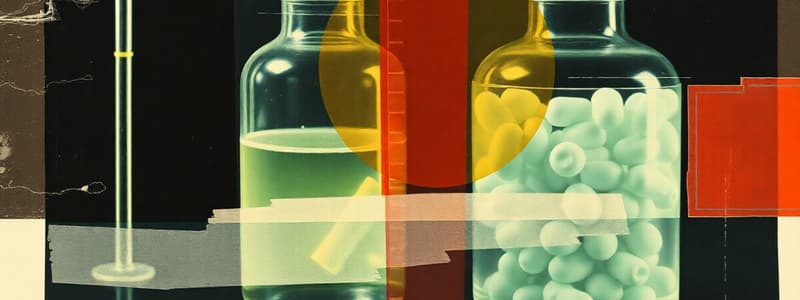Podcast
Questions and Answers
What is the primary purpose of a bioassay for antibiotics?
What is the primary purpose of a bioassay for antibiotics?
- To improve the growth conditions for microorganisms
- To determine the potency by comparing it with a standard preparation (correct)
- To evaluate the side effects of the antibiotic
- To identify the chemical structure of the antibiotic
In which temperature range must the inoculation medium be maintained during the inoculation process?
In which temperature range must the inoculation medium be maintained during the inoculation process?
- 48°C - 50°C (correct)
- 60°C - 65°C
- 30°C - 35°C
- 40°C - 45°C
What is the recommended depth for filling petri dishes with nutrient agar medium?
What is the recommended depth for filling petri dishes with nutrient agar medium?
- 1-2 mm
- 5-6 mm
- 3-4 mm (correct)
- 2-3 mm
What is the standard temperature at which the inoculated petri dishes are kept for drying?
What is the standard temperature at which the inoculated petri dishes are kept for drying?
Which microorganism is used in the inoculation process for the bioassay of Streptomycin?
Which microorganism is used in the inoculation process for the bioassay of Streptomycin?
What should be the internal diameter of the sterile cylinders used in the bioassay procedure?
What should be the internal diameter of the sterile cylinders used in the bioassay procedure?
How is the standard solution prepared for use in the bioassay?
How is the standard solution prepared for use in the bioassay?
What is the optimal incubation time for the petri dishes after placing the test and standard solutions?
What is the optimal incubation time for the petri dishes after placing the test and standard solutions?
Study Notes
Bioassay of Antibiotics
- The potency of an antibiotic is determined by comparing its inhibitory dose to a standard preparation of the antibiotic under the same conditions.
- Standard antibiotic preparations are supplied in sealed ampoules as dry powders.
- The potency of an antibiotic is measured in Units per mg of powder or mg per Unit.
- For example, 1mg of gentamicin sulphate contains 641 units, or 0.00156mg contains 1 unit.
Biological assay of Streptomycin
- The procedure involves using petri dishes with a 3-4mm depth of nutrient agar medium inoculated with Bacillus subtilis.
- The medium must be kept at a temperature between 48°C and 50°C during inoculation to ensure consistent growth.
- Uniform thickness of the medium is crucial for accurate results.
- Prepare sterile cylinders (glass, porcelain, aluminum, or stainless steel) that are 10mm high and have an internal diameter of 5mm, maintaining them at 150°C.
- These cylinders are placed on the surface of the inoculated nutrient agar, with 4, 6, or 8 cylinders per petri dish.
- If cylinders are not available, holes of 5-8mm in diameter can be bored into the medium.
- Prepare a standard solution with a known concentration and a test solution in a sterile solution with a pH of 8.
- Use a sterile pipette to place the solutions into the cylinders or holes, ensuring a uniform volume for each.
- Code the test and standard solutions appropriately for identification.
- Incubate the petri dishes at room temperature for 2-4 hours, followed by a 16-hour incubation at a suitable temperature.
Studying That Suits You
Use AI to generate personalized quizzes and flashcards to suit your learning preferences.
Related Documents
Description
Explore the procedures and principles underlying the bioassay of antibiotics, focusing on potency measurement and practical applications. This quiz covers essential techniques, including the biological assay of Streptomycin using Bacillus subtilis. Test your knowledge on antibiotic standards and assay methods.




